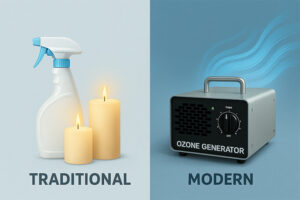
When stubborn odors take over your home, car, or business, the first reaction is often to reach for air fresheners, scented candles, or cleaning sprays. But do these traditional methods really solve the problem – or do they just cover it up? In this article, we’ll break down how traditional odor removal stacks up against professional Ozone Shock Treatment so you can decide what works best for you.
Traditional Odor Removal Methods
Before considering ozone shock treatment, many people try more traditional methods such as cleaning, airing out, or using odor-absorbing products.
1. Air Fresheners & Sprays
These are the most common quick fixes. While they might temporarily improve the smell, they simply mask the odor with fragrance. Once the scent fades, the original problem comes right back.
2. Surface & Source Cleaning
For many odor problems, thorough cleaning is the first step — especially for spills, pet accidents, or trash. If the odor has penetrated deeper into materials such as carpets, drywall, insulation, or ventilation systems, it’s essential to address the source directly. This may involve professional deep cleaning, replacing affected building materials, or cleaning HVAC ducts. Only after the source is removed should professional-grade ozone treatment be applied. Otherwise, odors may return, even after ozone treatment, if the root cause remains.
3. Ventilation
Opening windows and running fans can help freshen the air, but it’s rarely enough to remove strong odors like smoke, mold, or pet smells. Airflow helps dilute odors, but it doesn’t break down the actual odor-causing molecules.
Bottom line: Traditional methods can help with mild or recent smells, but they often treat the symptoms rather than the source.
Ozone Shock Treatment: How It Works
Ozone (O₃) is a powerful oxidizing agent that attacks and neutralizes odor molecules at the chemical level. Instead of covering smells, ozone breaks them apart so they’re gone for good.
- Reaches difficult areas – Ozone gas circulates through the treated space, reaching surfaces and materials that traditional cleaning may miss, such as upholstery, carpets, and HVAC ducts (if the source of the odor has been removed).
- Targets stubborn odors – Effective for reducing smoke, mold, pet odors, lingering cooking smells, and mustiness caused by water damage.
- Delivers quick impact – When applied correctly, ozone treatment can significantly improve air freshness.
If you’d like to learn more about how the process works in detail, check out our guide: What Is Ozone Odor Removal and How Does It Work?
Comparing the Ozone and Traditional Odor Removal
| Feature | Traditional Methods | Ozone Shock Treatment |
|---|---|---|
| Speed | Instant fragrance, but temporary | Works within hours for lasting results |
| Odor Coverage | Only covers what you can reach | Reaches hidden spaces and materials |
| Type of Action | Masks or partially removes odors | Breaks down odor molecules permanently |
| Best For | Light, short-term odor control | Strong or deeply embedded odors |
When to Choose Ozone
If you’re dealing with:
- Persistent smoke smell after a fire or heavy smoking indoors
- Pet odors in carpets, couches, or cars
- Musty smells from mold or water damage
- Cooking odors
…then ozone treatment is the most effective choice. It’s also a great option for preparing Airbnb or vacation rentals to ensure guests walk into a fresh, odor-free space.
Combining Both for Best Results
Traditional methods are fine for light, temporary odors. But if you want to permanently remove stubborn smells, ozone treatment is the clear winner. By targeting odor molecules directly, ozone delivers results that sprays and candles simply can’t match. For maximum freshness, start with a deep clean to remove dirt and visible residue. Then, schedule a professional ozone treatment to eliminate any remaining odors at the molecular level. This combination ensures the space not only looks clean but smells completely fresh.
